In June 2021, new COVID-19 cases in Iran rose as the more infectious Delta variant spread throughout the country. The Delta variant entered Iran via its south and southeastern provinces of Fars, Hormozgan, Kerman and Sistan and Baluchistan. It spread to other provinces during presidential elections held on June 18; many municipalities failed to follow health and safety protocols, according to President Hassan Rouhani. “There are concerns that the whole country may enter a fifth wave if enough care is not taken in following health protocols,” he warned on July 3.
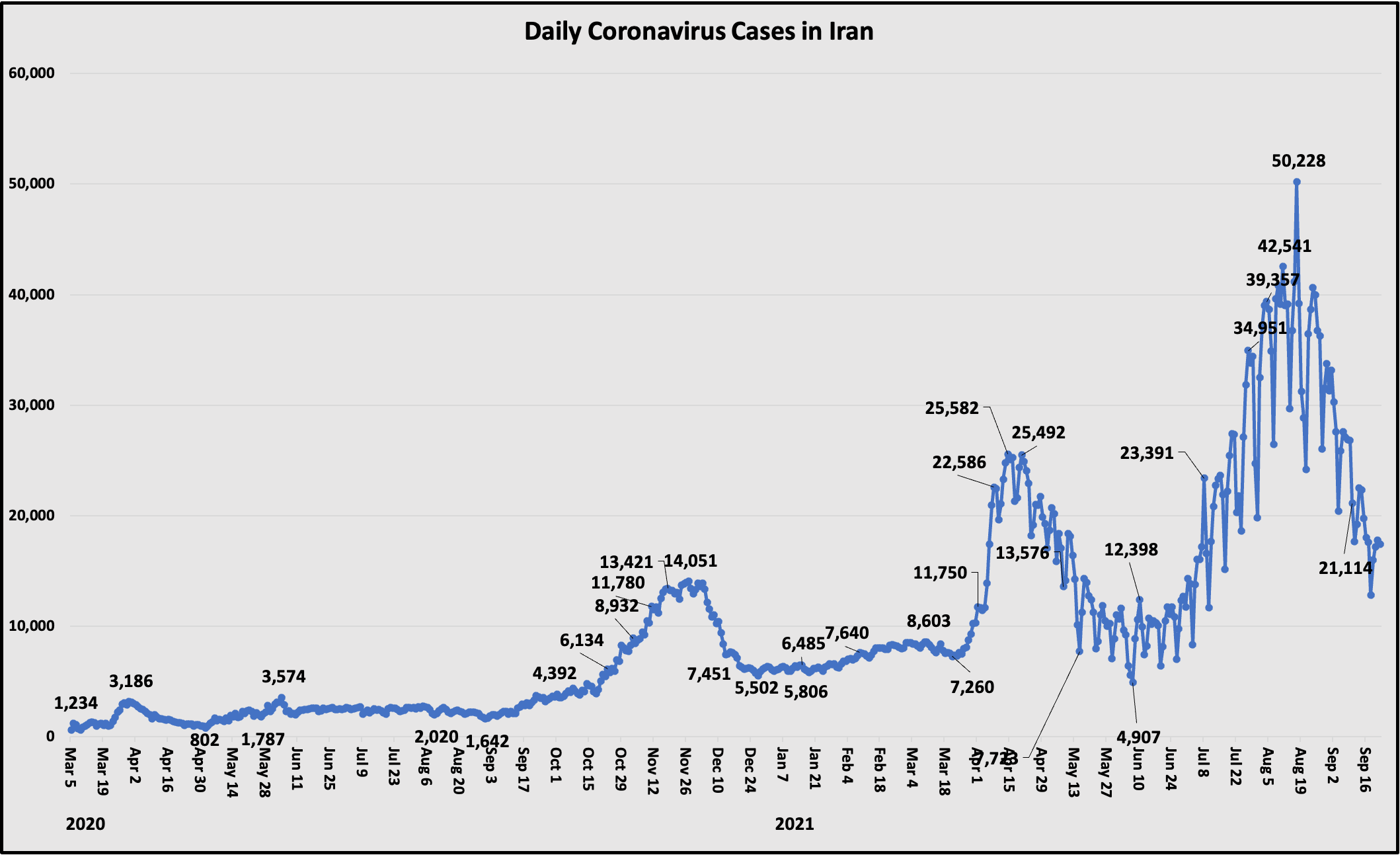
By July 3, more than 90 cities and towns were classified as “red” or “very high-risk” zones. The government reimposed a lockdown of all non-essential businesses in 275 cities, including Tehran. The lockdown affected “all public parks, restaurants, dessert shops, beauty salons, malls and bookstores” in “red” or “orange” (“very high” or “high” risk) cities, the Associated Press reported. The government also banned travel between cities with high COVID-19 infection rates and barred entry from 12 countries stricken with the Delta variant.
The spike in cases was worse than during the fourth and deadliest wave that began in March and ended in May. On July 8, new infections reached 23,391 – nearly as high as during the peak of 25,582 infections on April 14. By August 4, new infections had reached an all time high of 39,357.
But unlike in previous waves, the number of deaths from COVID-19 were initially low. Fewer than 200 people died each day, less than during the second wave of the coronavirus that began in May 2020 and ended in August 2020. But new deaths began to rise in mid-July and reached similar heights as during the third and fourth waves of the pandemic.
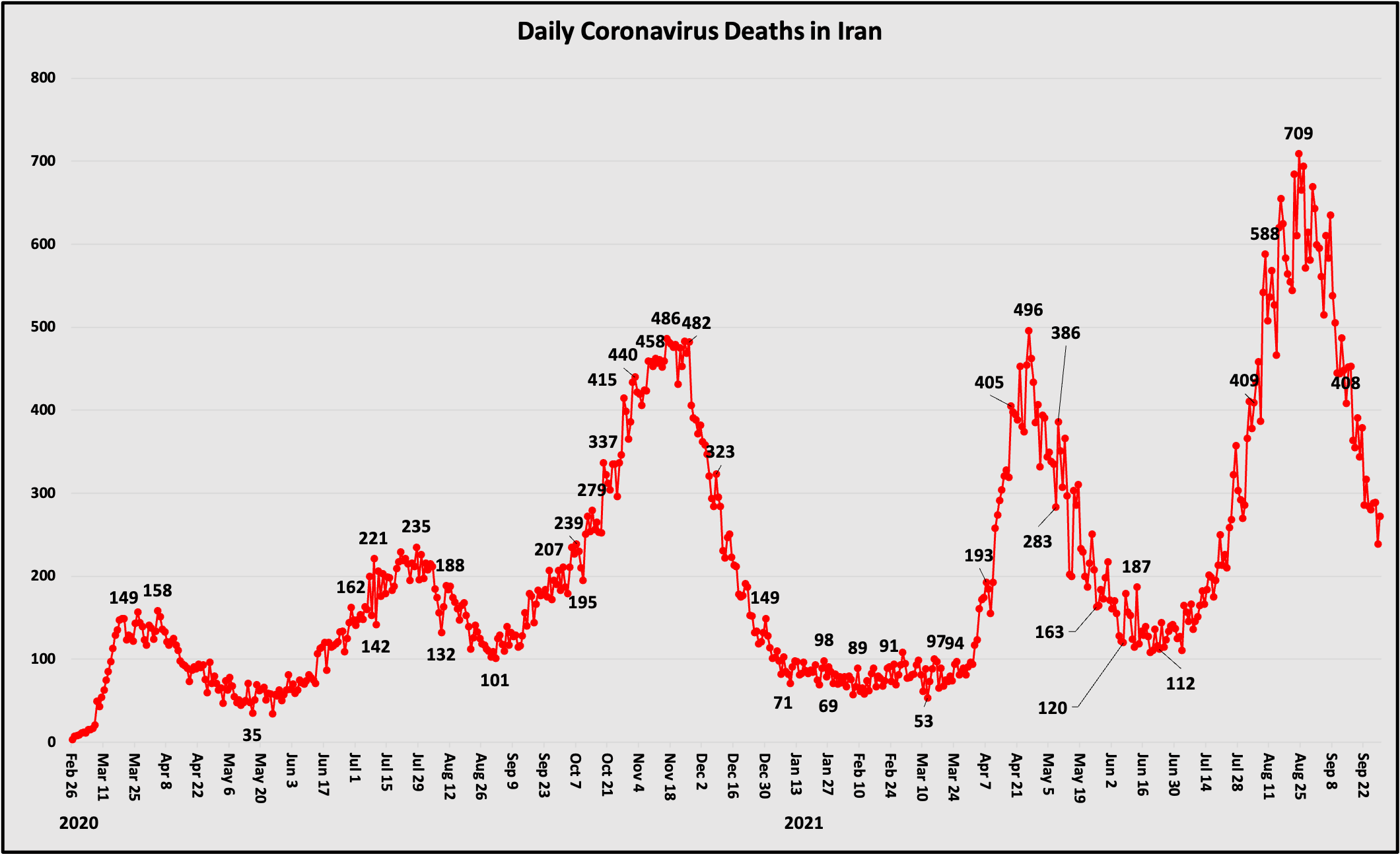
The deteriorating security situation in Afghanistan amid the U.S. military’s withdrawal and Taliban’s rapid advances exacerbated the health crisis. Thousands of Afghan migrants fleeing violence entered Iran via neighboring Sistan and Baluchistan province “without observing health protocols,” Esmail Hossein-Zehi, a lawmaker representing the province, warned on July 4. Nearly 1,000 new cases of new coronavirus cases in the province could be traced back to Afghan migrants, he added.
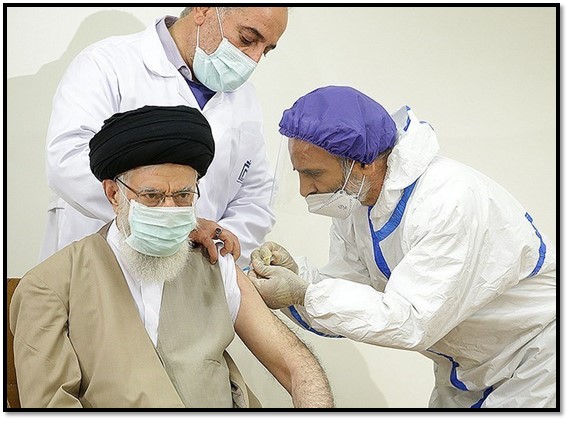
The Delta variant hit Iran amid a slow vaccination rollout. By July 14, only six percent of Iranians had received their first vaccine dose and only 2.5 percent had received two doses. The delay was due to a vaccine shortage. The first domestic vaccine, CovIran Barekat, was only approved for emergency use on June 14. Supreme Leader Ali Khamenei, who had previously banned vaccine imports from Britain and the United States, received his first shot of CovIran Barekat on June 25. “I did not want to use non-Iranian vaccines, so I said I would wait for the Iranian vaccine,” Khamenei said. On June 30, a second Iranian vaccine (co-developed with Cuba) – PastuCovac/Soberana-2 – was approved for emergency use.
Iran had four other domestic vaccines in various stages of testing and approval. The vaccines needed to go through at least three phases of human trials before approval.
- On May 8, Razi CovPars, a vaccine developed by a government-backed pharmaceutical company, entered the second phase of human trials. But the third phase would not begin until August 2021.
- On June 9, the defense ministry initiated the second phase of human trials for its Fakhra vaccine, which was named after the assassinated nuclear scientist Mohsen Fakhrizadeh.
- On June 27, the Revolutionary Guards unveiled and began human trials for its Noura vaccine. The vaccine was developed by Baqiyatallah University of Medical Sciences, a public university that is the "primary medical institution" for the Revolutionary Guards,according to the U.S. Treasury.
- On July 7, the Spicogen vaccine, jointly developed by Iran and an Australian pharmaceutical company based in Iran, entered the second phase of human trials.
Lawmakers warned that domestic vaccine production would not be enough to achieve herd immunity for Iran’s population of 84 million. “We need to vaccinate 60 million people, so we need 120 million doses of vaccine at present,” said Jalil Mirmohammadi Meibodi, a member of the parliamentary health commission. As of July 14, Iran had imported 9.4 million vaccine doses from abroad. Nearly one million doses were the Sputnik V vaccine donated by Russia, and another one million doses were the Sinopharm vaccine donated by China. The rest came from South Korea, India, Italy and the World Health Organization. The government said that it would import six million more by July 23 from China, Norway and Japan.
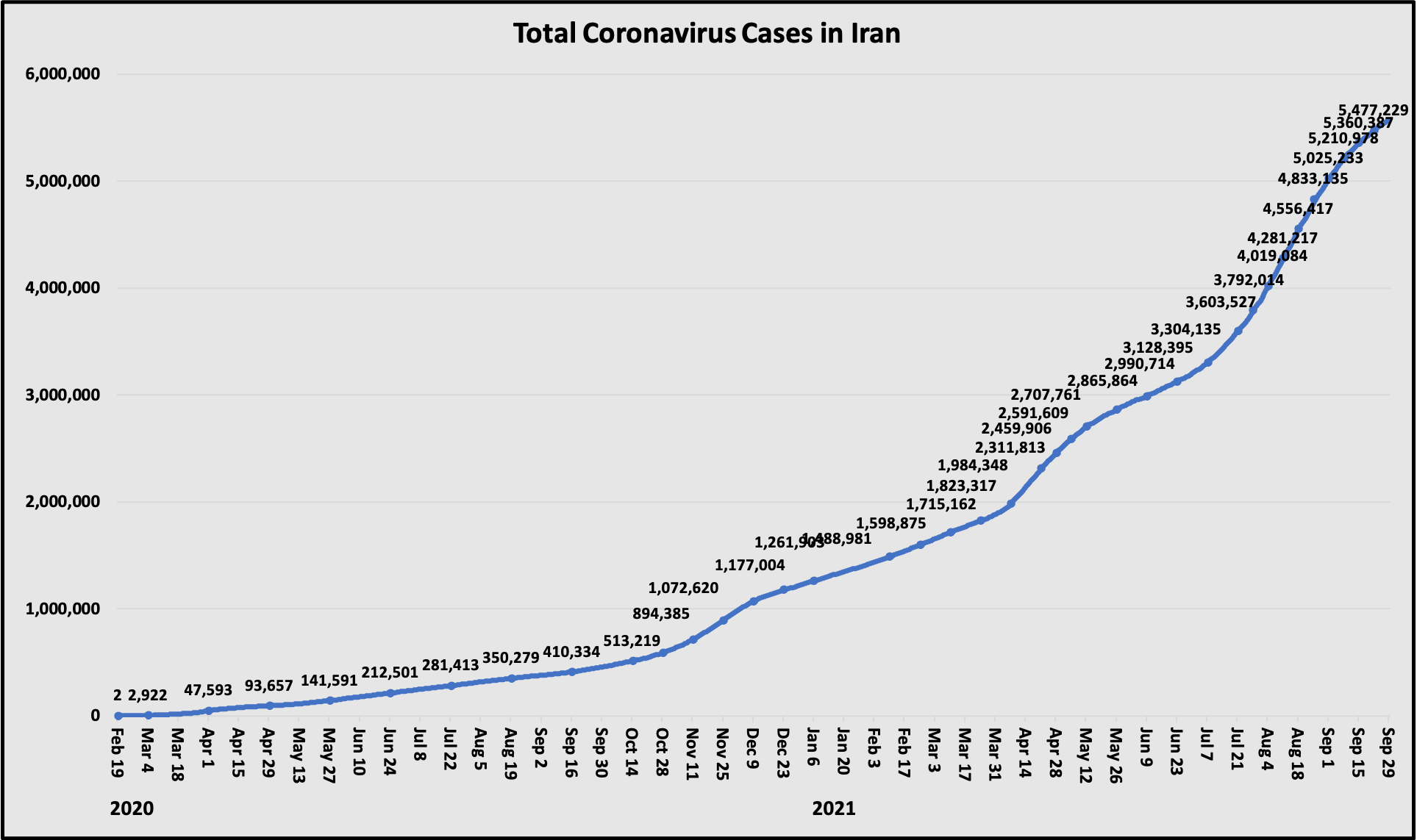
On July 10, President Rouhani warned that the Delta variant had "penetrated deep" into Iran despite the government’s best efforts. "The situation is more unfavorable than in previous weeks," he told the National Coronavirus Task Force. Rouhani urged Iranians to comply with health and safety protocols and pledged that the government would accelerate its vaccination campaign to inoculate 500,000 people per day.
Unable to get vaccinated at home, thousands of Iranians traveled to Armenia to get their shots, The New York Times reported on July 11. Tickets between the two capitals were sold out through late August. Videos on social media showed lines of cars at the border, some waiting 13 hours to cross. The manager for a Tehran bus company said that his weekly requests to get public transportation workers vaccinated had gone unanswered by the government, Iran International reported on July 13. The following is a timeline of the Delta variant outbreak in Iran in 2021.
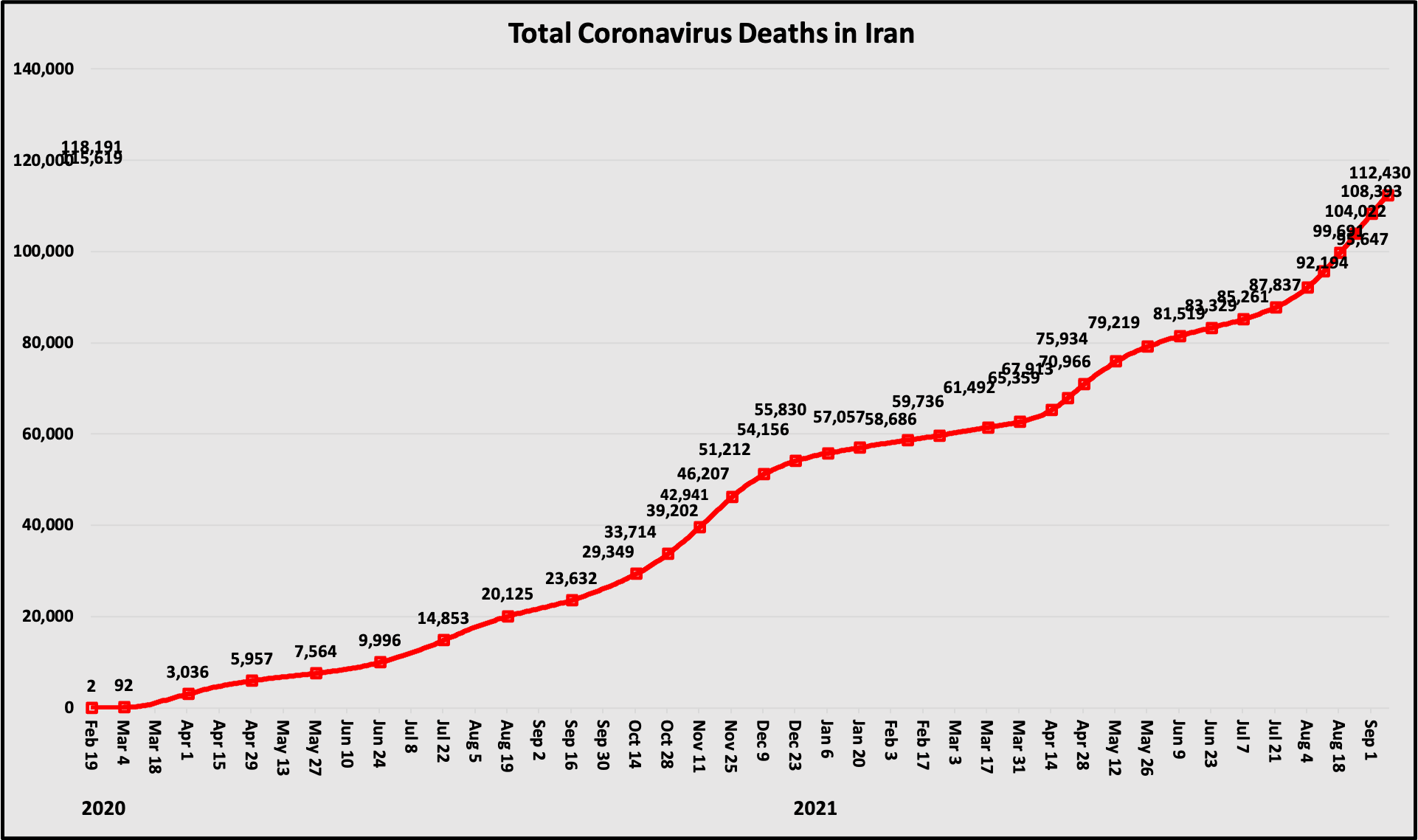
Related Material:
- One Year of COVID: Economic Impact
- One Year of COVID: Public Opinion
- One Year of COVID: Politics of Vaccination

Timeline:
Week 69: June 6 – June 12
On June 7, Ali Akbar Mohtashamipour, a former member of parliament, died from the coronavirus. He passed away in a hospital in northern Tehran, state-run IRNA reported. Mohtashamipour previously served as ambassador to Syria from 1982 to 1986 and helped establish Hezbollah, a Shiite Islamist militia, in Lebanon. In Parliament, he represented Tehran from 1990 to 1992 and from 2000 to 2004 as a hardliner. But he later joined the reformist faction and supported the opposition Green Movement, which disputed the reelection of President Mahmoud Ahmadinejad in 2009.
Related Material: One Year of COVID: Infected Officials
On June 8, the government approved new financial assistance to help businesses affected by the coronavirus, the Tehran Times reported. The package included tax waivers and deferred loan payments. The Iranian embassy in France requested that the government lift the ban on flights from Paris to Tehran. The embassy cited declining infection rates in France.
On June 9, Russia delivered 100,000 more vaccine doses to the Iranian Embassy in Moscow. The vaccines would be transported to Tehran on a Mahan Air flight by June 10. Since February, Iran has imported 900,000 doses of the Sputnik V vaccine from Russia.
Iran initiated the second phase of human trials for its Fakhra vaccine, a domestically-produced inoculation developed by the Ministry of Defense. Some 500 volunteers would receive the vaccine.
Iran's Tourism Ministry said that it had reached an initial agreement with the Foreign Ministry, Health Ministry and Interior Ministry to issue tourist visas by mid-July. "The issuance of tourist visas will resume after the final preparation and approval of travel regulations and protocols," the deputy tourism minister said.
On June 10, some 8,000 volunteers received the first dose of the CovIran Barekat vaccine as part of the third phase of human trials.
Week 70: June 13 – June 19
On June 14, Iran approved emergency use of CovIran Barekat, its first domestically developed vaccine. Health Minister Namaki said that a permit for the second vaccine, Razi CovPars, would be issued the following week. "The entire target population of Iran will be vaccinated by the end of coming fall,” he said.
On June 16, Al Jazeera reported on how the coronavirus had affected the presidential election. The government limited indoor gatherings to 15-30 people and mandated that large rallies could only be held outdoors. Election authorities increased the number of voting booths and placed them outdoors for Friday's vote.
Week 71: June 20 – June 26
On June 20, the Soberana 2 vaccine - which Iran is helping Cuba to test and produce - demonstrated a 62 percent efficacy rate with two of its three doses. Cuba expected an even higher efficacy rate in test subjects who receive the third shot, said the director of Cuba's state-run Finlay Vaccine Institute.
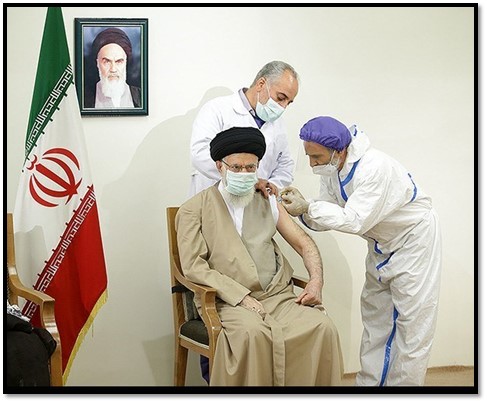
On June 22, President-elect Ebrahim Raisi pledged to procure more vaccinations once in office. "The quickest general vaccination...will be among our immediate programs from the first day of the government," he said in a speech in Mashhad. Raisi said that his government would procure more domestically-produced vaccines as well as "if necessary, those produced abroad."
On June 25, Supreme Leader Khamenei received his first shot of the domestically-produced CovIran Barekat vaccine. The supreme leader's office said that he had two conditions for being vaccinated: he did not want to receive his shot out of turn, and he would receive a domestically-made vaccine. "I did not want to use non-Iranian vaccines, so I said I would wait for the Iranian vaccine," Khamenei, who is 82, said. Iranians over the age of 80 became eligible for vaccination in March.
Khamenei had previously banned all vaccine imports from the United States and Britain, which produced the first viable vaccines. The supreme leader added that using foreign vaccines from Russia and China was "not a problem" but urged people to "respect the Iranian vaccine and thank all the young scientists who worked hard and actively in the production."
On June 27, the Revolutionary Guards unveiled the Noura vaccine, the second vaccine affiliated with the Iranian military. The vaccine was developed by Baqiyatallah University of Medical Sciences, a public university that is the "primary medical institution" for the Revolutionary Guards, according to the U.S. Treasury. Lab tests on mice, rabbits and monkeys were successful, and human clinical trials would begin immediately, state-run IRNA reported.
Week 72: June 27 – July 3
On June 30, a second Iranian vaccine – PastuCovac/Soberana 2 – was approved for emergency use, the health ministry said. The vaccine, codeveloped by Cuba and Iran, was 62 percent effective against new COVID-19 variants, the Tehran Times reported.
On July 1, President Rouhani urged Iranians to fully comply with health protocols to avoid a fifth wave of the coronavirus. He warned that failure to do so would require the government to "impose severe restrictions again." The president added that "in no way" should foreign nationals infected with the coronavirus be allowed to enter Iran.
On July 2, the government banned entry for travelers from 12 countries to prevent the spread of the coronavirus and its more infectious Delta variant. The affected countries were Botswana, Brazil, Eswatini, India, Lesotho, Malawi, Mozambique, Nepal, South Africa, Uruguay, Zambia and Zimbabwe. The travel ban would go into effect on July 4.
On July 3, President Rouhani warned that the COVID-19 Delta variant was spreading throughout Iran, particularly in the southern provinces. More than 90 counties were classified as "red" or "very high-risk" zones. "If the health protocols in these areas are not followed, the number of red cities in the country will increase," the president told the National Coronavirus Task Force.
Rouhani attributed the rise in cases to public gatherings during presidential and local elections on June 18. "Despite warnings in recent weeks, during the elections, especially in the council elections, the measures taken were not in line with health protocols," he said. Rouhani added that all Iranians had to follow public health guidelines through the end of the year, "whether people have been vaccinated or not."
Week 73: July 4 – July 10
#COVID19 #Iran:
— Slovenia in Iran (@sloiniran) July 4, 2021
The number of #COVID19 cases is increasing again in 🇮🇷. Provinces, predominantly in the SE and SW are classified as high risk and are red-coded (including #Tehran) as the more contagious Delta virus variant spreads rapidly across the country. pic.twitter.com/ZMwYkGeFcG
On July 4, the government banned travel between cities with high COVID-19 infection rates and reimposed a lockdown of all non-essential businesses in 275 cities, including Tehran. The lockdown affected "all public parks, restaurants, dessert shops, beauty salons, malls and bookstores" in cities classified as "red" or "orange," the Associated Press reported. New coronavirus infections rose 13.2 percent over the previous week, a health ministry spokesperson said.
On July 5, an ethnic Baluch lawmaker accused Afghan migrants of bringing the Delta coronavirus variant to Iran, the Tehran Times reported. "In the wake of rising violence in Afghanistan, the number of migrants to Sistan and Baluchistan (province) has increased," parliamentarian Esmail Hossein-Zehi said. "Unfortunately, a majority of the people enter the country without observing health protocols."
On July 7, the intelligence ministry said that it had disbanded a vaccine smuggling network and arrested its members. The network had illegally purchased, sold and distributed foreign vaccines, including Sinopharm, AstraZeneca and Pfizer, state-run IRNA reported.
On July 8, a lawmaker warned that domestic vaccine production would not be sufficient for Iran's entire population. "Three million doses of [CovIran] Barekat vaccine and about one and a half million doses of Pasteur vaccine per month is not a significant number," said Jalil Mirmohammadi Meibodi, who sits on the parliamentary health commission. He advised the government to increase vaccine imports from abroad. "We need to vaccinate 60 million people, so we need 120 million doses of vaccine at present."
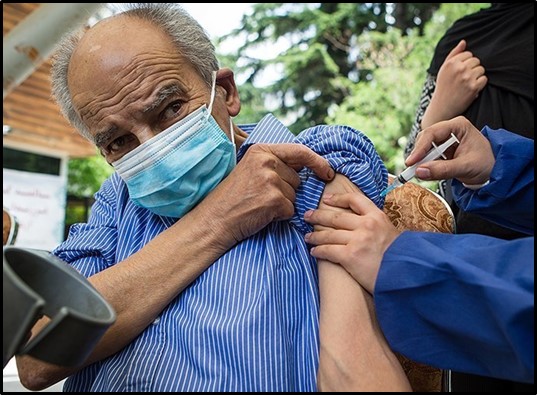
Iranian officials rejected media claims that its domestic vaccine production had been sabotaged by the United States. "The news of U.S. sabotage is not true... the production line of CovIran Barakat is operating with full capacity," Shifapharmed Industrial Group, a state-funded biotechnical group involved in manufacturing vaccines. Mohammad Marandi, a hardline media pundit, had reportedly claimed that COVID-19 vaccines had "been delayed due to an American hostile act," the Tehran Times reported in a tweet. Marandi later said that he had been misquoted and the Tehran Times deleted the tweet.
On July 10, the health ministry said that Iran would import six million more coronavirus vaccine doses by July 23. The vaccines would come from "China, Norway and Japan" as well as "other official sources," a health ministry official said.
President Rouhani warned that "despite all efforts" the COVID-19 Delta variant had "penetrated deep" into Iran. "The situation is more unfavorable than in previous weeks," he told the National Coronavirus Task Force. Rouhani said that only 66 percent of people were complying with health protocols and that 85 percent compliance was required to get the virus under control. "We ask people to follow the protocols so that we can get through these difficult conditions."
Week 74: July 11 – July 17
On July 11, Iran had imposed flight restrictions on flights to 39 countries, the civil aviation authority said. Iranians could not enter those countries without presenting a negative COVID-19 test before and after arrival.
Thousands of Iranians have traveled to Armenia to get vaccinated, The New York Times reported. Tickets between the two capitals were sold out through late August. Videos on social media showed lines of cars at the border, some waiting 13 hours to cross.
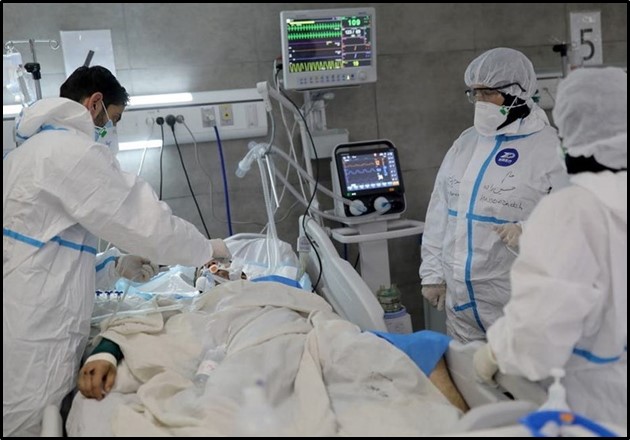
On July 12, the European Union donated $17.7 million (15 million euros) to Iran to help with COVID-19 relief efforts and hosting of Afghan refugees. The funds will go to humanitarian organizations, as well as provide Iran with "urgent medical equipment," the European Commission said in a statement.
As of July 13, some 425 taxi drivers have died from the coronavirus, Iran International reported. One taxi driver estimated that 40 to 50 drivers in Tehran died from COVID-19 each month in 2021. The Japanese government pledged that it would donate 2.9 million vaccine doses to Iran through the World Health Organization's COVAX program.
As of July 14, Iran had imported 9.4 million vaccine doses from abroad since February, the Tehran Times reported. The government received 2.1 million vaccines via the World Health Organization's COVAX program, one million from Russia and one million from China. The rest came from India, Italy and South Korea.
On July 17, Rouhani said that more than seven million doses of the vaccine had been injected since February. "We will live up to our promise of vaccination by the end of this government’s term of office," he told the National Coronavirus Task Force.
The president implored more Iranians to follow public health guideline to avoid contracting the Delta variant. "On average, 48 percent of the protocols are followed in the country, which is very low," he said. "People should know that vaccination must not cause them to ignore health protocols," he added.
Week 75: July 18 – July 24
On July 18, Setad, the state-owned foundation responsible for producing CovIran Barekat, said that it had enough raw material for 100 million doses of the vaccine. "The production technology for this Iranian coronavirus vaccine is fully indigenous, and we need no country in the processing of the jab," a Setad spokesman said. The supervisor of clinical trials for CovIran Barekat confirmed that the vaccine was effective against the Delta variant.
On July 19, Iran imposed a week-long lockdown of Tehran to deal with the surge in the COVID-19 Delta variant. Most non-essential businesses were already closed, but the new order expanded the lockdown to include all bazaars, markets and government buildings, the Associated Press reported.
More than 8,500 Iranians visited Armenia in June, many for vaccines, Reuters reported. "Demand for vaccines has created an opportunity for our travel agencies which I encourage them to take," said the deputy head of Armenia's tourism committee. All foreigners had to wait at least 10 days before becoming eligible for the AstraZeneca vaccine.
On July 20, Iran reached an all-time high of new COVID-19 infections with 27,444 new cases, the health ministry reported. The previous peak was 25,582 on April 14. New deaths were at 250, still lower than the average death rate during the third and fourth waves of the pandemic in fall 2020 and spring 2021 respectively.
On July 22, An Iranian diplomat said that Tehran would import 2.2 million more vaccine doses from China, as well as an additional one million doses from Japan. The government expected to receive nine million more doses from Japan.
Week 76: July 25 – July 31
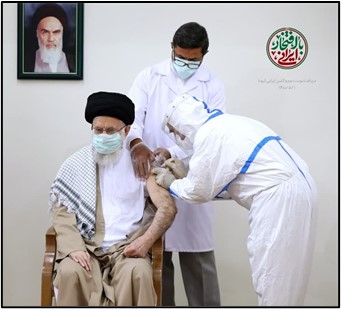
On July 23, Khamenei received his second dose of the CovIran Barekat vaccine. The supreme leader blamed delays in the vaccination campaign on foreign suppliers. “In some cases, there was a disruption in the issue of distributing the vaccine among people, which, of course, was mainly due to the unfulfilled promises of those who vowed to sell the vaccine to us," he said.
The first shipment of vaccines from Japan arrived in Tehran, state-run IRNA news agency reported. Iran received 1.1 million doses of the AstraZeneca vaccine.
On July 25, Iran received 1.1 million doses of vaccines from abroad via the Iranian Red Crescent Society (IRSC). More than 10 million vaccines had been imported by the IRSC.
On July 24, the health ministry reported that more than 10 million Iranians—12 percent of the population—have received at least one dose of the COVID-19 vaccine. Some 7.6 million had received their first dose, while 2.4 million had received their second dose.
On July 27, Iran recorded back-to-back days of all-time high new infections: 31,815 new infections on July 26 and 34,900 on July 27. The health ministry warned that just 40 percent of Iranians were wearing masks to prevent the spread of the disease. "If health protocols are followed as they are now, we will not have much hope of getting out of the (high risk) 'red' situation," Health Minister Namaki said.
On July 28, Cuba said that Iran would begin producing the Soberana 2 vaccine on an industrial scale the following week, Reuters reported.
On July 29, Iran received 100,000 doses of the Sputnik V vaccine from Russia, state-run IRNA news agency reported.
On July 30, Iran received 1.1 million doses of the AstraZeneca vaccines from Japan, its second shipment from the east Asian country.
On July 31, Hossein Salami, the commander in chief of the Revolutionary Guards, received his first dose of a vaccine "produced in Iran," state-run Mehr News Agency reported. The specific vaccine that Salami received was not identified.
President Rouhani said that his administration "did its best to combat [the] coronavirus" and wished the incoming Raisi administration "its best" on containing and controlling the disease. “From the very beginning of the outbreak of coronavirus in the country, we had to rely on our own domestic strength," Rouhani said. “There was no help for Iran, so we had to rely solely on our own domestic resources to provide all the equipment and medicines we needed."
Iran received 750,000 more vaccine doses from Japan, state-run IRNA news agency reported. The IRGC-affiliated Noora vaccine successfully completed the first phase of human trails, the Tehran Times reported.
Week 77: August 1 – August 7
On August 1, an additional 200,000 doses of the CovIran Barekat vaccine were delivered to health ministry, according to Setad. The delivery raised the number of total CovIran Barekat vaccines in government hands to 1.5 million. The IRSC imported another 1.12 million vaccines into Iran.
On August 2, Iran reached another all-time high of new COVID-19 infections, with more than 37,000 cases reported. Khamenei ordered the government to take all "necessary measures" to contain the Delta variant outbreak, including consideration of a two-week lockdown of the entire country. Iran received 1.1 million doses of vaccines from China out of a planned delivery of 2.2 million doses.
On August 4, Iran hit another record high of new infections; more than 39,000 new cases of the coronavirus were recorded.
On August 7, the Spicogen vaccine, developed jointly by Iran and an Australian pharmaceutical company, entered the third phase of human trials. The vaccine was 70 percent effective against the virus in its second phase of trials, the Tehran Times reported.
Week 78: August 8 – August 14

On August 8, President Ebrahim Raisi received his first dose of the CovIran Barekat vaccine and encouraged vaccine manufacturers to "accelerate" production. "Public vaccination is an unavoidable necessity and one of the priorities of the government so that we can increase the public resistance of the people against this virus and its possible mutations," he said after receiving his shot.
Iran has sufficient foreign currency reserves to import COVID-19 vaccines, the Central Bank of Iran (CBI) said. CBI Governor Akbar Komeijani told IRIB that all bank employees would receive the second dose of the vaccine next month.
The IRSC imported another 1.11 million doses of the coronavirus vaccine, state-run IRNA reported.
On August 9, Iran recorded new daily highs for infections and deaths, the health ministry reported. More than 40,000 new cases were recorded and 588 Iranians died from the coronavirus. “Every two seconds one person gets infected in Iran and almost every two minutes one person dies from the coronavirus,” state TV reported.
Raisi urged "maximum observance" of health protocols during the Islamic holy month of Muharram. Stadiums and open air buildings should cooperate with the government to organize mourning ceremonies for Hussein ibn Ali, the third imam of Shiite Muslims, Raisi told his cabinet.
Interior Minister Abdolreza Rahmani Fazli met with provincial governors to discuss the health situation, state-run IRNA reported. “We are both concerned about the (health) protocols and the significance and respect for Muharram rituals,” he said.
Hospitalizations due to the Delta variant were twice as high as during the fourth wave of the pandemic (which ran from March to May 2021), Deputy Health Minister Ghasem Janbabaei said. He claimed that the current fifth wave would be the last Iran suffered due to increasing vaccination rates, Tasnim News Agency reported.
On August 10, President Raisi issued new orders aimed at containing the coronavirus, including increasing the supply of oxygen, reviewing existing health protocols and providing unlimited foreign reserve currency needed to import vaccines. He also instructed the Government Economic Coordination Headquarters to help distribute medicine and medical equipment to people across the country. He visited the COVID-19 ward of Imam Khomeini Hospital in Tehran.
The Razi CovPars, Iran's second domestically-produced vaccine, demonstrated 80 percent effectiveness in the second phase of human trials, Iran Front Page News reported. The Razi Institute, the pharmaceutical company developing the vaccine, planned to produce 15 to 20 million doses by March 2022, a company spokesperson said.
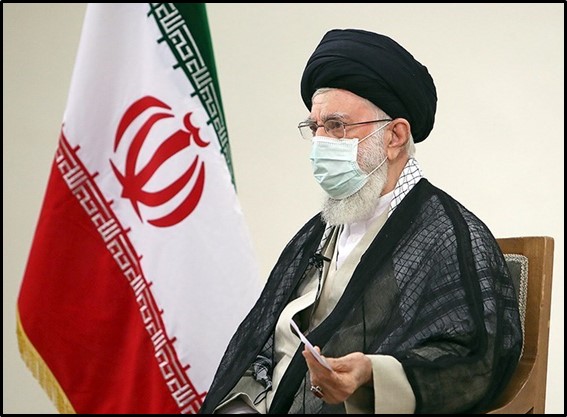
On August 11, Supreme Leader Khamenei urged the government and insurance companies to provide free COVID-19 testing for all Iranians. "Today, it is not available for everyone," he said in a televised speech. "There are problems. It has costs for people. It has heavy costs for some.” He ordered the military to do whatever is necessary to contain the pandemic. "This disease has gone wild not only in Iran, but almost all over the world," he said. "As the disease, the virus, or the enemy takes on a new form, we must change our defense form and our method."
Khamenei accused Western governments of breaking promises to sell vaccines to Iran. He urged the government to boost domestic production as well as vaccine imports to "provide the people with the vaccine in whatever way possible." The supreme leader added that Muharram mourning ceremonies should be carefully organized to prevent the spread of the virus. "We need these ceremonies...but they should be held with utmost care and by observing all protocols," he said.
President Raisi instructed Foreign Minister Mohammad Javad Zarif to negotiate increased import of vaccines from abroad on an accelerated timeline.
Iran would soon administer one million vaccines per day, Health Minister Saeed Namaki claimed. But Iranians were frustrated with the low supply of foreign vaccines, the Associated Press reported. Shots of Moderna and Pfizer vaccines sold on the black market for as much as $1,350 a dose. Russia had only delivered one million out of 60 million promised shots, while China has sent 10 million shots and Japan nearly three million.
On August 12, the Imam Khomeini Hospital Complex in Tehran had no more beds in its ward for coronavirus patients, State Radio Iran (VIRI) reported. The government claimed that it had secured 40 million additional doses of imported vaccines for the fall, state-run IRNA reported. The IRCS delivered 1.1 million additional doses of the vaccine to Imam Khomeini International Airport in Tehran.
On August 13, President Raisi urged Iranians to reconsider travel plans to prevent the spread of the Delta variant. “The reduction of travel is one of the central issues in the process of controlling the virus, so travel and traffic must be significantly reduced in the next 10 days,” he told the National Coronavirus Task Force. The president also asked state media to help keep Iranians well-informed of health protocols and the spread of the virus.
The true death toll from COVID-19 was likely closer to 1,000 per day, The New York Times reported.
On August 14, Iran imposed a six day lockdown of the entire country until August 21. The lockdown applied to "all bazaars, markets and public offices, as well as movie theaters, gyms and restaurants in all Iranian cities," the Associated Press reported. The government also banned all road travel until August 27, except for vehicles delivering essential goods or medical services. "This traffic ban will be very strictly imposed," the spokesman for the National Coronavirus Task Force said.
President Raisi said that Iran had secured 30 million doses of the COVID-19 vaccine from abroad but that 60 million would be required.
The IRSC denied that it had diverted COVID-19 vaccines meant for Iran to Venezuela, the Tehran Times reported. The denial was in response to a viral video showing crates of Sinopharm vaccines at Imam Khomeini Airport in mid-transit, an IRSC spokesman said. “When the consignment of another country arrives at Imam Khomeini Airport, this is a kind of cargo transit, and investigations have shown that this consignment was transferred from China to Iran to be sent to Venezuela," he said.
Security forces arrested six Iranians who were planning to sue the government for mishandling its response to the pandemic. Four were lawyers and two were civil society activists, according to the New York-based Center for Human Rights in Iran (CHRI). Their phones and personal belongings were confiscated upon arrest. One of the lawyers, Leila Heydari, was released the next day.
Week 79: August 15 – August 21
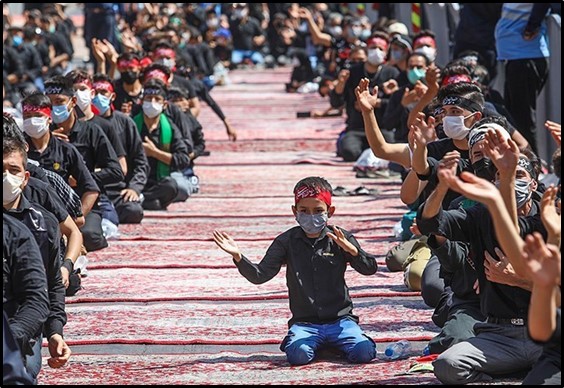
On August 16, Iran hit a record high 655 deaths from the coronavirus and could reach 800 per day in the coming weeks, Reuters reported. The government issued permits for U.S.-made Pfizer and Moderna vaccines despite an earlier ban by Supreme Leader Khamenei. Mohammad Reza Shanesaz, the head of the Iranian Food and Drug Administration, said that the vaccines came from "permissible sources."
On August 17, Iran received an additional 700,000 vaccine doses from China, according to the Iranian foreign ministry. Beijing had sent a total 1.55 million doses to Iran since February, said Reza Zabib, the director general of the Asia-Pacific Department.
Iran had administered 12 million doses of China's Sinopharm vaccines, four million doses of the Oxford-AstraZeneca vaccine, one million doses of the domestically-produced CovIran Barekat and fewer than a million doses of Russia's Sputnik V and India's Covaxin vaccines, according to the head of virology research at the Pasteur Institute in Tehran.
On August 18, President Raisi sided with Beijing over its rejection of a second WHO probe into the origins of the coronavirus. "The politicization of the source of the COVID-19 pandemic is a serious threat to global health and is an example of some countries' efforts to isolate China," Raisi told Chinese President Xi Jinping in a phone call. Xi promised to do his "utmost to deliver the vaccine to Iran and help Iran overcome [the] coronavirus."
On August 19, the IRSC pledged to double the number of vaccines it imported in the following month. Karim Hemmati, president of the IRSC, said that the organization had been importing doses from China and would continue to do so. More than 100,000 Iranians have died from COVID-19 since February 2020, the health ministry reported.
On August 20, Iran expanded eligibility for the COVID-19 vaccine to all mothers working in health care or pregnant women over the age of 35. Women with spouses working in coronavirus hospital wards were also eligible, state-run IRNA reported. President Raisi told the National Coronavirus Task Force that Xi had promised to accelerate shipments of vaccines to Iran.
Week 80: August 22 – August 28
On August 22, IRGC commander Major General Hossein Salami announced that the Noura vaccine, developed by the IRGC-affiliated Baqiyatallah University of Medical Sciences, had entered the second phase of clinical trials.
On August 23, the national Union of Medicine Importers announced that Iran would receive 20 million doses of the previously-banned Pfizer vaccine by the end of 2021. The Iran Customs Administration said that the country had already imported 20.1 million Sinopharm vaccines from China, 2.9 million AstraZeneca vaccines from Japan, and 1 million Sputnik vaccines from Russia – in addition to smaller batches of vaccines from South Korea, India, and Italy – since February 3, 2021.
On August 24, Iran reported a record daily high of 709 deaths, raising the total death toll to 103,357.
On August 26, Hossein Amir-Abdollahian, the newly confirmed foreign minister, said that the foreign ministry had established a special headquarters dedicated to expediting the import of vaccines. On the same day, Iran received its seventeenth vaccine shipment, which contained 1.1 million doses. Iran had received a total of 20.39 million doses from abroad.
On August 28, Defense Minister Mohammad Reza Qaraei Ashtiani announced that the Iranian Fakhra vaccine reached its final phase of testing and would be mass-manufactured in the near future.
Week 81: August 29 – September 4
On September 2, Iran received its third shipment of vaccines through the COVAX Facility program.
On September 4, the Iranian health ministry refuted media reports which alleged that Iran had produced and exported two million doses of the Sputnik vaccine to Russia each month. “The transfer of any kind of vaccines into and out of the country is subject to permission by the [Iranian] Food and Drug Organization, and such a permit has not been issued, so far, for coronavirus vaccines,” said Kianoush Jahanbakhsh, the spokesman for the Iranian Food and Drug Organization.
In a live television interview, President Raisi, lauded domestic efforts to produce vaccines. But he acknowledged that Iran needed doses from abroad as well. He announced that Iran would import 40 million by mid-September 2021.
Week 82: September 5 – September 11
On September 5, President Raisi received his second dose of the CovIran Barekat vaccine. Meanwhile, the Iranian Red Crescent Society received its eighteenth consignment of COVID-19 vaccines, containing five million doses.
On September 7, Austrian Foreign Minister Alexander Schallenberg tweeted, “I am pleased that Austria is supporting the people of #Iran with 1 million doses of #AstraZeneca #vaccines against #COVID19.”
The first half of a 1million doses donation of AstraZeneca vaccine from Austria was welcomed by an Austrian Embassy team led by CdA Barbara Grosse at IKA.Austria is convinced that joint efforts are needed to counter the global Covid19 crisis.Nobody is safe until everybody is safe pic.twitter.com/CP9J0XirAA
— Austrian Embassy Tehran (@AustriainIran) September 8, 2021
On September 8, the director of the Iran Pasteur Institute announced that the PastoCoVac vaccine, jointly developed by Iran and Cuba, passed the clinical test on children in Cuba. The vaccine was subsequently cleared for use on Iranian children.
On September 9, President Ebrahim Raisisaid that his administration would fight the latest COVID-19 surge in four ways: supporting domestic vaccine production; importing more vaccines; accelerating vaccination programs; and implementing an updated “Martyr Soleimani” plan, in which thousands of volunteers go door-to-door screening people for COVID-19.
The health ministry said that the worst phase of the ongoing COVID-19 wave had passed.
On September 11, the Iranian Red Crescent Society said that Iran would soon vaccinate students aged 12 to 18.
Week 82: September 12 – September 18
On September 13, the Health Minister Bahram Einollahi said that Iran’s Fakhra vaccine passed to its third clinical trial with 40,000 volunteers.
Protestors gathered outside of the Interior Ministry to condemn mandatory vaccinations.
The Foreign Ministry said that Iran will remove any “red lines” for importing COVID-19 vaccines, including those developed by American companies Pfizer and Moderna.
On September 14, the Health Minister Einollahi said that Iran will import 40 million doses of COVID-19 vaccine between September 23 and October 22, 2021, the Iranian month of Mehr.
On September 15, an Iranian health official said that nearly 40 percent of Iranians had received their first dose of a COVID-19 vaccine.
On September 16, Mohammad Reza Shanehsaz, the head of Iran’s Food and Drug Administration, announced that two more vaccines were approved for use in Iran, the Johnson & Johnson vaccine developed in the United States and Russia’s Sputnik Light. Both were single-dose vaccines.
Week 83: September 19 – September 25

On September 21, President Ebrahim Raisi said that U.S. sanctions on Iran amid the COVID-19 pandemic, “especially in the area of humanitarian items,” amounted to an “organized crime against humanity.” In his debut address to the United Nations, Raisi condemned the punitive measures as “oppressive.” Under U.S. law, humanitarian goods are not subject to sanctions, but some U.S. and foreign companies and banks have been reluctant to do business with Iran for fear of running afoul of the complex U.S. sanctions regime.
The Barekat Foundation said that it had delivered six million doses of the domestic CovIran Barekat vaccine to the health ministry.
On September 22, Iranian Foreign Minister Hossein Amir-Abdollahian thanked his Austrian counterpart Alexander Schallenberg for his country’s vaccine donations. The two met on the sidelines of the U.N. General Assembly.
On September 25, Iran kicked off a new school year with relaxed restrictions on in-person learning for some 15 million students. The public school system planned a gradual reopening that combined distance learning and in-person instruction, especially for larger schools.
Week 84: September 26 – October 2
On September 26, the health ministry reported that more than 50 million vaccination doses had been administered. More than 35 million people had received one dose, and more than 15 million had received two doses.
